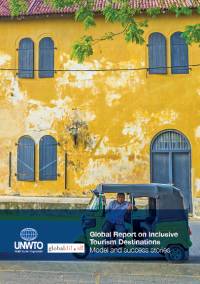 Holidays for All is a key section in a new research report by Barclays. It is a pity that this section ends up in the latter part of the report because it applies to all other sections. The tips and case studies in a pdf document cover all aspects of the hospitality and tourism business. Although the report focuses on the UK domestic tourism market, the principles for increased business are applicable elsewhere.
Holidays for All is a key section in a new research report by Barclays. It is a pity that this section ends up in the latter part of the report because it applies to all other sections. The tips and case studies in a pdf document cover all aspects of the hospitality and tourism business. Although the report focuses on the UK domestic tourism market, the principles for increased business are applicable elsewhere.
The title of the report is the Great British Staycation. It is a very readable report and the section on holidays for all is worth a look, and it ends with strategies for success with key points from each of the chapters:
-
- Know your demographic
- Foster Loyalty
- Capture early bookers
- Add value through collaboration
- Reap digital dividends
- Provide options where possible
- Take them behind the screen
- Be accessible to all
It is not unusual to find references to accessibility and inclusion somewhere in a subheading of a research report. This is unfortunate because this is the one part that applies to all other sections. See also the economic argument from Simon Darcy.

 If local and state governments aren’t listening to residents about mobility, walkability, and wheelability then perhaps they might consider visitors and tourists with money to spend locally. But are they really interested in the extra tourist dollars? Does the local Chamber of Commerce think it’s all too difficult to create greater access and inclusion? The walkability issue isn’t just about footpaths, seating and toilets – it’s about all the links in the chain to make it happen – joined up thinking. Otherwise we end up with islands of access and inclusion. And you can’t be a bit inclusive – it either is or it isn’t. That means business, community and governments need to work in unison on the design of physical environments, customer service and tourist information. And of course the reverse of the question is, “Can walkability improve tourism?”
If local and state governments aren’t listening to residents about mobility, walkability, and wheelability then perhaps they might consider visitors and tourists with money to spend locally. But are they really interested in the extra tourist dollars? Does the local Chamber of Commerce think it’s all too difficult to create greater access and inclusion? The walkability issue isn’t just about footpaths, seating and toilets – it’s about all the links in the chain to make it happen – joined up thinking. Otherwise we end up with islands of access and inclusion. And you can’t be a bit inclusive – it either is or it isn’t. That means business, community and governments need to work in unison on the design of physical environments, customer service and tourist information. And of course the reverse of the question is, “Can walkability improve tourism?” International travel is a great experience for everyone especially when operators get on board with inclusive thinking. In
International travel is a great experience for everyone especially when operators get on board with inclusive thinking. In  A new magazine,
A new magazine,  Inclusive tourism has two outcomes. One, individuals and their families benefit from participating in tourism activity. Two, it can help with sustainable development and the reduction of poverty in developing countries. The
Inclusive tourism has two outcomes. One, individuals and their families benefit from participating in tourism activity. Two, it can help with sustainable development and the reduction of poverty in developing countries. The